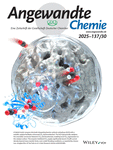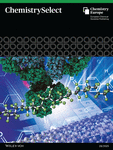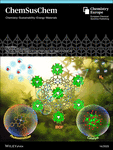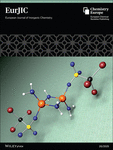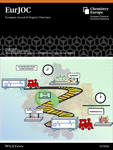Journal list menu
VIPs
The following papers are very important or outstanding in the opinion of two referees.

Designing New Natural-Mimetic Phosphatidic Acid: A Versatile and Innovative Synthetic Strategy for Glycerophospholipid Research
Dr. Antoine Schlichter, Dr. Alexander Wolf, Thomas Ferrand, Dr. Aurelien Cocq, Dr. Lina Riachy, Dr. Steven Vertueux, Brice Beauvais, Marine Courvalet, Paul-Joël Henry, Dr. Emeline Tanguy, Dr. Louis Gonzales, Dr. Rémy Ferlet, Dr. Fanny Laguerre, Dr. Charles Decraene, Alexia Pellissier, Dr. Muriel Sebban, Dr. Cyrille Sabot, Dr. Lydie Jeandel, Dr. Sarah Cianférani, Dr. Jean-Marc Strub, Dr. Magalie Bénard, Dr. Victor Flon, Dr. Valérie Peulon-Agasse, Prof. Pascal Cardinael, Dr. Stéphane Ory, Dr. Stéphane Gasman, Prof. Pierre-Yves Renard, Prof. Maïté Montero-Hadjadje, Dr. Nicolas Vitale, Dr. Sébastien Balieu

We report the role of the fatty acyl chains in biological activities of phosphatidic acids (PA). Several PA probes having two different fatty acyl chains were synthesized through a multi-steps synthesis and bearing various fluorophores or photo-cross-linkers (PCL). We demonstrate that our probes maintain the biological activities of the natural PA, then we found hundreds of new proteins interacting with PA in function of their chain compositions.

C60 Fullerene as the Active Site for CO2 Electroreduction
Si-Wei Ying, Yuhang Wang, Peng Du, Qiang Wang, Changming Yue, Di Zhang, Zuo-Chang Chen, Jian-Wei Zheng, Su-Yuan Xie, Hao Li
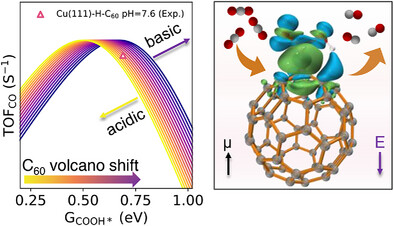
We reveal a striking finding: Fullerene (C60), beyond its classical role as an electron buffer, can directly serve as a molecular active site for CO₂ reduction. Through data mining, ab initio simulations, and pH-field coupled microkinetics, we uncover that C60’s unique curvature induces strong dipole responses, stabilizing COOH* intermediates and enabling a pH-dependent volcano. This work redefines the catalytic nature of curved carbon materials.

Functionalized Calix[4]Nanocones
Anika Haidisch, Dr. Frank Rominger, Prof.Dr. Michael Mastalerz
![Functionalized Calix[4]Nanocones Functionalized Calix[4]Nanocones](/cms/asset/2d9dc505-ddcf-49b9-b45f-a7e893e6c8c6/anie202512873-gra-0001-m.jpg)
Herein we present a synthesis of a nanocone based on a calix[4]arene, which has additional functional groups at the peripheral rims. Due to its rigid structure in combination with alkoxy groups on both the upper and the lower rim, the nanocone was tested for the binding of alkaline ions in solution. It exhibits high selectivity for binding Na+ over Li+ and also K+ in CDCl3.

Reversible Structural Oscillation Mediates Stable Oxygen Evolution Reaction
Dr. Qunlei Wen, Dr. Tianyang Liu, Dr. Danji Huang, Dr. Yu Lin, Zhenhong Yang, Dr. Ruoou Yang, Prof. Youwen Liu, Prof. Xiaomeng Ai, Prof. Jiakun Fang, Prof. Yafei Li, Prof. Bao Yu Xia, Prof. Shijie Cheng, Prof. Tianyou Zhai

This study reveals that dynamic structural oscillations within the [Ni-O2-Fe] units of NiFe LDHs identified a strong dependence on the alternating active Fe dissolution and redeposition, thus mediating the dynamic stability. Further, engineering the oscillation manners via the in situ sulfur leaching and cobalt-induced electron-withdrawing effects achieves unprecedented industrial-scale durability (>800 h @ 8000 mA) and a record energy efficiency (4.05 kWh Nm−3 H2 at 4000 A m−2).

Understanding Optical Properties and Electronic Structures of High-Entropy Alloyed Perovskite Nanocrystals
Yung-Tai Chiang, Sunil B. Shivarudraiah, Alexander Wieczorek, Khoong Hong Khoo, Zhidong Leong, Jia Wei Melvin Lim, Zengshan Xing, Sudhir Kumar, Simon F. Solari, Yen-Ting Li, Yu-Cheng Chiu, Tze Chien Sum, Yun Liu, Sebastian Siol, Chih-Jen Shih
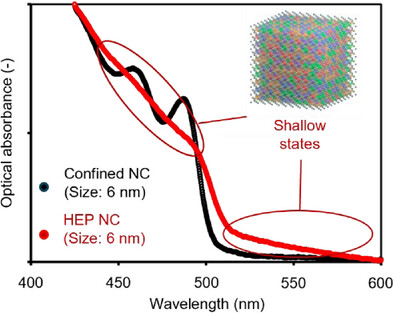
High entropy perovskite (HEP) nanocrystals (NCs) are synthesized and their anomalous optical and electronic signatures are characterized by temperature-dependent photophysical measurements, electron microscopy, X-ray photoelectron spectroscopy, and density functional theory. Despite the smaller size of HEP NCs than the Bohr diameter of pristine NCs, they possess wider bandgaps and featureless band structures due to the formation of shallow states. In situ luminescence analysis further demonstrates the superior photostability of HEP NCs thin films.

Multiaxial Aromatic-Based Photoferroelectric Induced by Synergistic Intermolecular Interactions for Multidirectional Self-Powered X-Ray Detection
Lijun Xu, Prof. Zhenyue Wu, Huang Ye, Qianwen Guan, Hang Li, Chengshu Zhang, Prof. Chengmin Ji, Prof. Junhua Luo
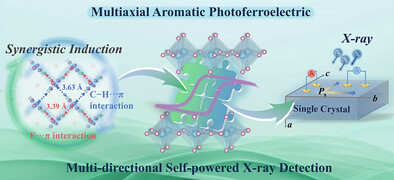
In this work, we report for the first time the successful design of a multiaxial aromatic-based photoferroelectric, (4-bromo-2-fluorobenzylammonium)2PbBr4, through synergistic noncovalent interactions between hydrogen bonding and fluorine-π, which achieves a stable multidirectional self-powered X-ray detection. The polycrystalline ferroelectric film also exhibits self-powered X-ray detection behavior, demonstrating the potential for next-generation flexible and thin-film integrated devices.

Plasma-Engineered Sub-10 nm Surface Fluorination Enables Ultraselective Hollow Fiber Membranes
Can Wang, Xiaobo Chen, Xing Liu, Zhenyuan Li, Prof. Ruixia Liu, Prof. Shuangjiang Luo, Prof. Suojiang Zhang
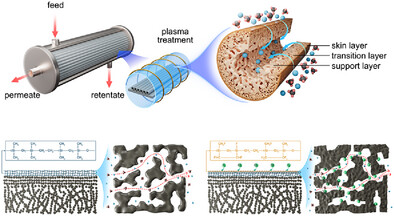
Surface fluorination of PDMS-coated hollow fiber membranes via CF4 plasma engineering achieves sub-10 nm nanoscale modification, simultaneously enhancing chain rigidity and narrowing pore size distribution. The optimized membrane demonstrates record gas separation performance with industrial-scale stability, surpassing the 2019 perfluoropolymer upper bounds and conventional polymeric hollow fiber membranes.

pH-Dependent Packing Mode Variations and Chirality Inversion in Short Peptide Self-Assembly
Xiaoyue Ma, Kai Qi, Xinfeng Ju, Yawei Sun, Hua Yang, Yubin Ke, Jun Zhang, Yurong Zhao, Hai Xu, Jiqian Wang
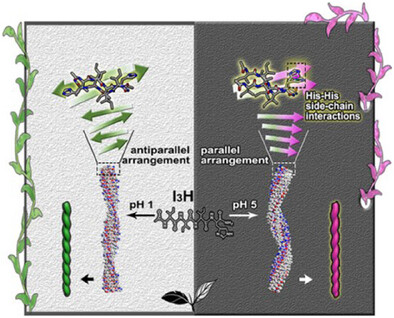
This work reports subtle pH-dependent chirality inversions through designed amphiphilic peptides. The underlying mechanism is revealed to be closely related to the protonation state of the hydrophilic His residue. The protonated His promotes antiparallel β-sheet packing and left-handed fibril assembly, whereas the deprotonated His facilitates parallel packing and right-handed fibril assembly, driven by interstrand His-His interactions.

Electro-responsive Tri-state Switch in Supramolecular Circuits
Min Tan, Xueyan Zhao, Zhibin Zhao, Adila Adijiang, Haibo Shu, Lichuan Chen, Zhiqiang Fan, Dong Xiang
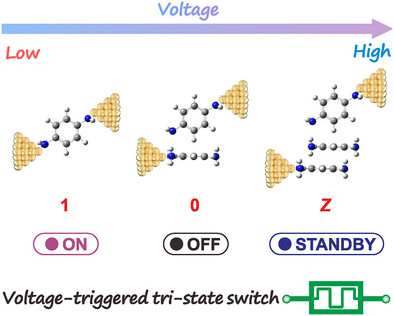
TOC: First demonstration of an electroresponsive multistable switch in a supramolecular circuit showing three distinct conductance states under bias voltages without chemical additives, enabling richer logic encoding, achieving an exceptional switching ratio of approximately 1.25×103 (one of the highest reported to date), and revealing the mechanism for the formation of molecular trimer junctions promoted by the applied electrical field.

In Situ Sulfur Modification Enables Electrochemical Selective Deuterated Thiol-Yne Reactions
Dr. Liyuan Lan, Dr. Ying Gao, Prof. Cuibo Liu, Prof. Bin Zhang, Prof. Kun Xu, Prof. Chengchu Zeng
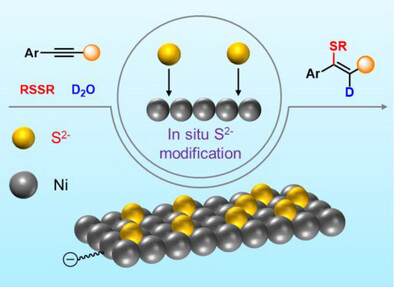
An in situ sulfur modification strategy is reported to convert a commercial NF cathode into a NiSx-modified electrode through lattice infiltration of electrochemically generated S2⁻. The in situ formed electrode enables the electrochemical deuterothiolation of alkynes with disulfides (RSSR) and D2O, affording D-labeled vinyl sulfides with up to 98% alkene selectivity and 99% deuterated ratios. The RSSR serves a dual purpose by supplying RS⁻ and S2⁻ simultaneously.

The Design of Interfacial Organic-Riched Phase by Molecular Interlocking for Stable Zn Anodes
Min Yang, Yanan Zhang, Qingjie Li, Xiao Wang, Buyu Ma, Prof. Zhiqiang Niu
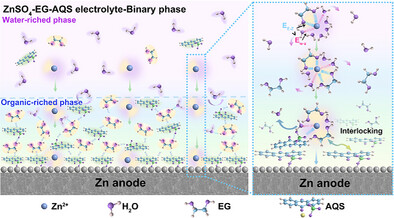
An organic-riched phase (ORP) layer was constructed on Zn anode surface by introducing sodium anthraquinone-1-sulfonate (AQS) into electrolyte. The zincophilic -SO3− groups of AQS molecules preferentially adsorb on Zn anode. Simultaneously, low-polarity and hydrophobic anthraquinone groups are emerged on the top surface of the AQS layer, attracting more AQS and EG molecules by the molecular interlocking effect to construct the ORP layer. This ORP layer will effectively inhibit the side reactions on Zn anodes.

Single-Atom Ligation of Four Different Alcohols at One Silicon Center: Methodology Development and Proof of Concept
Chao Wang, Xin Xu, Xinyu Zhang, Haifeng Lin, Jie Wang, Pathan Mosim Amin, Prof. Dr. Youliang Wang

Triphenylchlorosilane (Ph3SiCl) was developed as a tetrachlorosilane surrogate for the iterative and controllable ligation of four different alcohols to one silicon center to generate fully heteroleptic tetraalkoxysilanes. Mechanistic studies revealed the unusual transformations of Wheland intermediates into both silicon cations and silylated phenylhalonium ions in low and comparable activation barriers.

Synergistic Modulation of Intermediate Adsorption and Active Hydrogen Supply Enable Pulsed Nitrate-to-Hydroxylamine Electroreduction with Nearly 100% Faradaic Efficiency
Youwei Sheng, Hao Chen, Jiabing Geng, Dr. Hongjie Yu, Dr. Kai Deng, Dr. Ziqiang Wang, Prof. Hongjing Wang, Prof. Liang Wang, Dr. You Xu
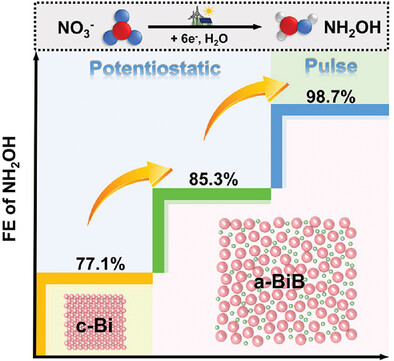
This study develops boron-doped amorphous bismuth metallene arrays for efficient nitrate-to-hydroxylamine electroreduction. The B-induced p-sp orbital hybridization and amorphous structure modulate the electronic configuration and increase active site density, thus optimizing intermediate adsorption and H* generation while lowering the energy barrier of the potential determining step. The catalyst achieves 85.3% NH₂OH Faradaic efficiency (FE) at −0.4 V versus RHE, which further rises to nearly 100% under pulsed potential operation, surpassing most reported systems.

Dual-Sided Multidentate Coordination Strategy Enables Record Birefringence in UV-Transparent Antimony-Based Hybrid Crystals
Pu Zhang, Prof. Xuehua Dong, Prof. Ling Huang, Prof. Zhien Lin, Prof. Yuqiao Zhou, Prof. Guohong Zou
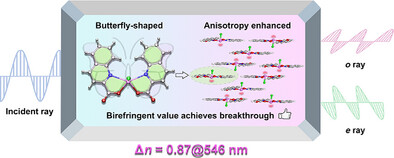
A butterfly-shaped UV-transparent hybrid birefringence crystal, (C10H6NO2)2SbF (QCSF), with a record-breaking birefringence of 0.87 at 546 nm, surpassing all previously reported halide birefringent crystals with SCALPs, was successfully designed and synthesized through a dual-sided multidentate coordination strategy.

Controlling Asymmetry Amplification Through Supramolecular Polymorphism
Camila Montañez-Moyano, Dr. Yuncong Xue, Dr. María Victoria Cappellari, Alejandro Martínez-Manjarrés, Lorenz Borsdorf, Prof. Dr. Cristian A. Strassert, Prof. Dr. Gustavo Fernández

Herein, using two proof-of-concept chiral (S)-1 and (R)-1 Pt(II) complexes along with a model achiral compound 2, we demonstrate the ability of supramolecular polymorphism to control and amplify asymmetry. By strategically merging the distinct properties of polymorphs of (S)-1 and 2, we achieved a remarkable synergistic communication between chirality and luminescence in their coassemblies, paving the way for adaptive supramolecular materials with emergent functionalities.

Sub-Ångstrom Pore Engineering in Carbon Molecular Sieves Realizes Diffusion-Gated Kinetic Sieving of Alkenes from Alkanes
Dr. Fuqiang Chen, Dr. Hua Shang, Dr. Guangtong Hai, Xinlei Huang, Zhe Chu, Dr. Haoran Sun, Liu Yang, Prof. Qiwei Yang, Prof. Zhiguo Zhang, Prof. Qilong Ren, Prof. Zongbi Bao
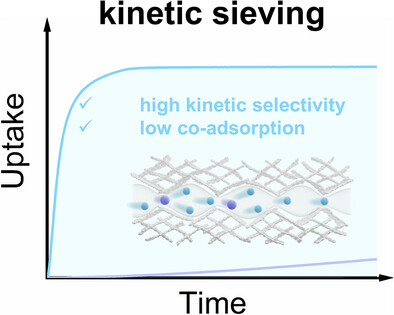
Sub-Ångstrom engineering of slit-pore carbon molecular sieves (CMSs) enables diffusion-gated kinetic sieving of alkenes over alkanes. The optimized CMSs exhibit high alkene/alkane selectivity, low co-adsorption, and near-complete alkene recovery in pressure swing adsorption (PSA) operations, establishing a practical route for energy-efficient alkene purifications.

Atomic-Level Design of Acid-Base Pairs in Oxides for Selective Catalytic Reduction of Nitrogen Oxides with Ammonia
Guoquan Liu, He Zhang, Pengfei Wang, Chao Gao, Zechao Zhuang, Prof. Dingsheng Wang, Prof. Sihui Zhan
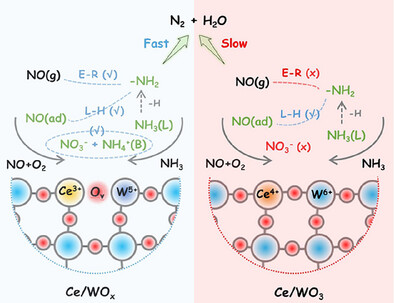
It is still a novel yet challenging task to influence and alter reaction pathways by regulating active sites, while the Ce-Ov-W acid-base pairs regulated by oxygen vacancies accelerate the reaction between NH3 and gaseous/adsorbed NO, following enhanced Langmuir-Hinshelwood and Eley-Rideal mechanisms. The strategy tunes the catalytic activity at the atomic scale and provides fresh hints for rationally controlling the reaction pathways toward efficient nitrogen oxide (NOx) removal.

Stretch-Induced Structural Ordering and Orientation for Tensile Yield Behavior and Anisotropic Optical Property of Molecular Granular Materials
Wei Liu-Fu, Shengqiu Liu, Dr. Jiadong Chen, Dr. Jia-Fu Yin, Prof. Dr. Panchao Yin
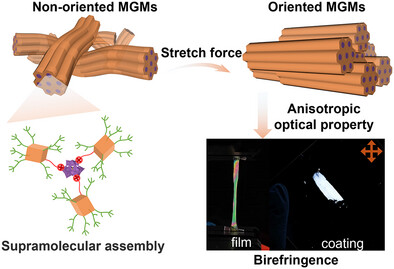
The molecular granular materials (MGMs) based on functional molecular clusters with hierarchical structures can be feasibly synthesized through supramolecular interaction. The stretch process contributes to the structural orientation and ordering of the MGMs with viscoelasticity and anisotropic optical property.

Synthesis and Reactivity of a Mono-Coordinated Triplet Bismuthinidene
Dr. Yannick Schulte, Timo Freese, Dr. Christoph Wölper, Jan Schulte, Prof. Dr. Gebhard Haberhauer, Prof. Dr. Stephan Schulz

Dehydrogenation of Ar*BiH2 3 yielded the kinetically stabilized mono-coordinated triplet bismuthinidene 4, which was structurally characterized by sc-XRD and whose electronic character was analyzed by quantum chemical calculations. Bismuthinidene 4 reacts with alkyl halides with oxidative addition to bismuthanes Ar*Bi(R)X, which react with LiAlH4 to the corresponding room temperature-stable bismuthanes Ar*Bi(R)H.

Engineering the Microporous Environment of Flexible Metal-Organic Frameworks with Bifunctionality for Promoting the Separation of Ethylene from a Ternary Mixture
Kang Wang, Prof. Yao Jiang, Hui Zhang, Shaojun Jia, Prof. Qi Wang, Prof. Peng Cui, Prof. Thamraa AlShahrani, Prof. Shengqian Ma
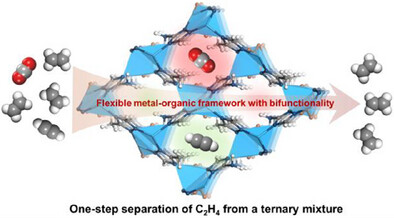
A rationally designed flexible metal-organic framework featuring an engineered microporous environment with bifunctionality was achieved to provide high binding affinity for both CO2 and C2H2 and to enable efficient one-step separation of C2H4 from a ternary mixture of CO2/C2H2/C2H4.

Sub-1 nm CuO-Phosphomolybdic Acid Nanosheets for Ultrasound-Controlled Pyroptosis Activation and Tumor Immunotherapy
Dr. Junhao Shao, Dr. Binbin Ding, Dr. Hao Chen, Dr. Zhendong Liu, Dr. Sainan Liu, Dr. Xinyu Ma, Dr. Jiwei Wang, Dr. Zhanfeng Wang, Dr. Jiashi Zhang, Dr. Kuo He, Dr. Yarui Hu, Prof. Ping'an Ma, Prof. Jun Lin

Under US irradiation, copper oxide-phosphomolybdic acid (CuO-PMA) effectively generates ¹O₂ and •O₂⁻, depletes GSH, and controls the valence transition of Cu(II)/Cu(I), enhancing the generation of •OH. This process leads to mitochondrial oxidative stress, releases damage-associated molecular patterns, and activates pyroptosis, triggering a strong antitumor immune response.

Entire Near-Infrared-I Electrochemiluminescence Enhancement of Gold Nanoclusters
Dr. Zhao-Chen Shen, Yi-Fei Chen, Prof. Ya-Qin Chai, Assoc. Prof. Jia-Li Liu, Prof. Ruo Yuan
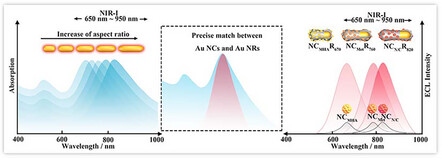
An entire near-infrared-I (NIR-I) ECL enhancement strategy of gold nanoclusters (NCx, x represents the ligand of gold nanoclusters) is reported by regulating absorption wavelength of gold nanorods to precisely match ECL emission wavelength of gold nanoclusters (NCxRy, y represents the longitudinal plasmon resonance absorption wavelength of the gold nanorods), and the ECL intensity of NCxRy is 3-4 times higher than that of individual NCx.

Versatile Halide-Pair-Driven Multicomponent Polymerization for Library Synthesis of Sequence-Controlled Semiconducting Dendronized Polymers
Hae-Nam Choi, Su-Min Ko, Semin Son, Ji-Su Woo, Hyunwoo Park, Dong Joon Lee, Prof. Tae-Lim Choi, Prof. Won-Jin Kwak, Prof. Hwan Myung Kim, Prof. In-Hwan Lee
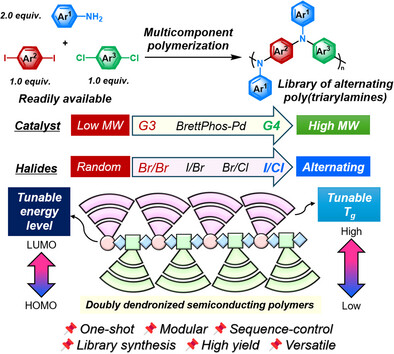
A halide-pair-driven multicomponent polymerization (MCP) strategy enables the efficient synthesis of diverse sequence-controlled semiconducting poly(triarylamine)s (PTAAs), including dendronized variants, advancing the development of next-generation organic materials.

Spinel-Layered Heterostructure Enables Reversible Oxygen Redox in Lithium Manganese Oxide
Dr. Yanfang Wang, Dr. Cheng Li, Yulin Cao, Dr. Juping Xu, Dominic Gardner, Dr. Wilgner Lima da Silva, Yongcong Huang, Fangchang Zhang, Mingzhou Li, Dr. Yingzhi Li, Prof. Wen Yin, Prof. Kaili Zhang, Prof. Phoebe K. Allan, Prof. Zhouguang Lu
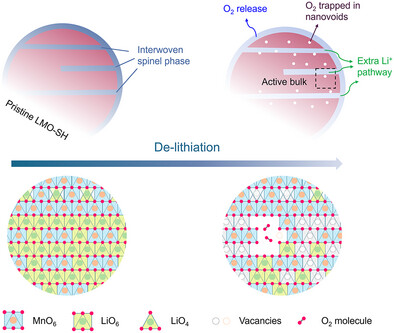
A layered lithium manganese oxide with spinel heterostructures (LMO-SH) was prepared via a novel synthetic method. It has lithium-rich local environments and exhibits reversible oxygen redox activities, distinct from the conventional Li2MnO3. The spinel heterostructure provides extra Li+ pathways to activate the bulk activity and traps oxygen molecules (O2) for reversible reduction.

Unlocking the Power of Lewis Basicity in Oxide Lattice Oxygens: A Regulating Force for Enhanced Oxygen Evolution Kinetics in Li-O2 Batteries
Hao-Min Guan, Zhi-Peng Cai, Prof. Xue-Yan Wu, Prof. Kai-Xue Wang, Prof. Jie-Sheng Chen

Lewis basicity of lattice oxygen is activated in our high entropy spinel oxide (LB-HEO). Through Lewis acid-base interaction, LB-HEO attracts acidic Li+, leading to more disorder and Li+ defects in the discharge product Li2O2 of lithium-oxygen batteries. This promotes Li+ diffusion in Li2O2 and interfacial electron transfer, eventually improving the decomposition kinetics during charging. It provides a new perspective on the regulation of Li+ behavior to achieve better electrochemical performance.

Universal Chemical Presodiation Under Air Condition for Highly Stable Na-deficient Oxide Cathodes
Fei Li, Yaohui Huang, Tong Zhang, Zihao Song, Xiangshuai Wei, Prof. Fujun Li
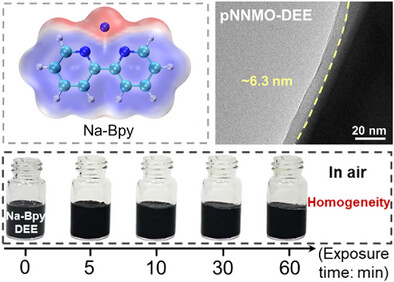
A universal chemical presodiation strategy using Na-Bpy/DEE is proposed for Na-deficient oxide cathodes under air condition, which promotes formation of uniform and robust NaF-rich interface during presodiation. This minimizes stress accumulation and structure distortion upon Na+ intercalation/extraction to exhibit high-capacity retention.

Remote and Spatiotemporal Modulation of Supramolecular Self-Assembly of Croconaine Dyes via NIR Laser Irradiation
Yangge Ren, Juanjuan Gao, Tiantian Cai, Linyuan Liu, Hao Huang, Yujia Guo, Xinyu Hou, Yue Lu, Lin Jia

In this study, we demonstrate a light-mediated strategy for fabricating supramolecular polymers and copolymers. By tuning laser power, irradiation time, and wavelength, supramolecular structures can be precisely controlled. The spatial precision of laser irradiation further enables localized supramolecular polymerization and sol-gel transitions. These findings establish a dynamic platform for regulating supramolecular nanomaterials with tailored structures and functions.

Sulfur Mediated Interfacial Proton-Directed Transfer Boosts Electrocatalytic Nitric Oxide Reduction to Ammonia over Dual-Site Catalysts
Zhenlin Wang, Assoc. Prof. Haiyan Duan, Wenqiang Qu, Donglin Han, Xingchi Li, Li Zhu, Xuan Jiang, Prof. Danhong Cheng, Yongjie Shen, Dr. Ming Xie, Prof. Emiliano Cortes, Prof. Dengsong Zhang
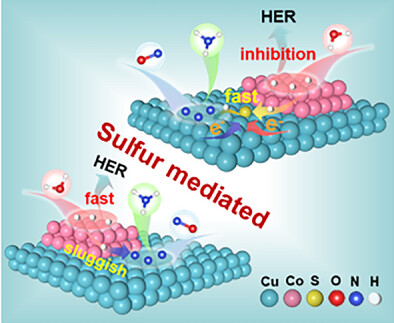
Sulfur-mediated electron redistribution and proton-directed transfer at the Cu-Co interface significantly boost electrocatalytic NO reduction to NH3 over the S-Cu@Co/C catalyst. The changes in the electronic structure of Cu and Co promote NO adsorption and water dissociation. Meanwhile, sulfur accelerates the transfer of protons generated at Co sites to Cu sites, thereby facilitating NO hydrogenation and suppressing HER.

Exceptional Second Harmonic Generation in Ultraviolet Nonlinear Optical Oxyfluoroniobate Crystals via Structural Fingerprint Optimization of Polar Chains
Dr. Congcong Jin, Dr. Yang Li, Jin Seong Kim, Jong-Hoon Lim, Hongbo Huang, Dr. Chong-An Chen, Jihyun Lee, Yejin Heo, Bingbing Zhang, Prof. Joon Ik Jang, Prof. Kang Min Ok
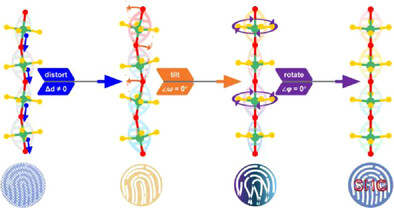
A structural fingerprint optimization strategy is proposed for the 1[TMOF4]∞ chain-based compounds, aimed at modifying the geometric features of functional chains to maximize the optical nonlinearity. In the ultraviolet (UV) nonlinear optical (NLO) crystal (H3O)(Biu)2(NbOF4), the structural fingerprints of the functional chains satisfy the ideal criteria, resulting in a record-breaking second harmonic generation (SHG) response (10.8 × KH2PO4) among all known transition metal (TM) oxyfluorides.

Intracellular Delivery of Native Proteins by BioReversible Arginine Modification (BioRAM) on Amino Groups
Jonathan Franke, Jan Vincent V. Arafiles, Christian Leis, Christian P. R. Hackenberger
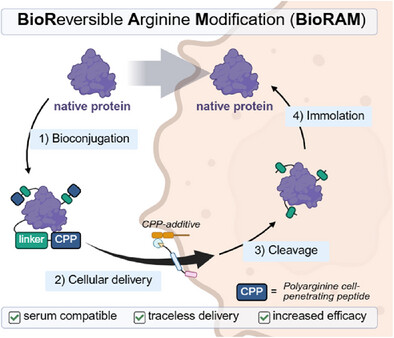
Bioreversible Arginine Modification of amine-containing protein residues (termed BioRAM) allows the serum-compatible, readily accessible, and efficient delivery of native proteins into live cells. Combined with cell-penetrating peptide (CPP) additives, BioRAM results in intracellular RNase A activity at nanomolar concentrations, thus enabling the cellular delivery of native protein cargoes without additional genetic engineering.

Asymmetric, Corner-Sharing CuO5 and CuO6 Motifs in Cu-Based Metallic Perovskite Oxides Boosting Asymmetric C─C Coupling for CO2 Electroreduction to C2+
Yu Zhang, Hongyan Zhao, Junjie Zhu, Zitao Chen, Xiangjian Liu, Zhenbao Zhang, Lei Shi, Xuezeng Tian, Heqing Jiang, Yongfa Zhu, Jiawei Zhu
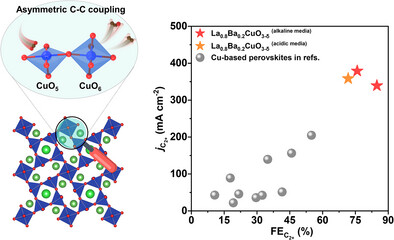
A unique type of Cu-based metallic perovskite oxides with asymmetric, corner-sharing CuO5 and CuO6 motifs were reported to promote asymmetric C─C coupling for efficient CO2-to-C2+ conversion. As a proof-of-concept catalyst, La0.8Ba0.2CuO3-δ was the most effective Cu-based-perovskite catalyst for C2+ production and performed comparably with or better than most reported Cu-based catalysts.

Orchestrating Penta-Element Interplay in Gradient-Porous Carbons for Advanced Sodium-Ion Hybrid Capacitors
Yangjie Liu, Yao Guo, Yu Zhang, Lihong Xu, Junxiang Chen, Xiang Hu, Zhenhai Wen
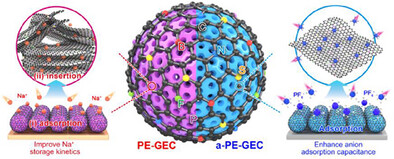
The correlation between the active sites induced by promete and the Na+ storage capacity as well as anion adsorption/desorption has been established through a combination of electrochemical analysis, machine learning potentials, and molecular dynamics simulations, which enhances the kinetics and capacity balance of anode and cathode for sodium-ion hybrid capacitors.

Non-Amphiphilic Antimicrobial Polymers
Alain M. Bapolisi, Dr. Anne-Catherine Lehnen, Dr. Martin Wolff, Jana Kramer, Dr. Sergio Kogikoski Jr., René Steinbrecher, Dr. Nicole Michler, Dr. Andreas Kiesow, Prof. Ilko Bald, Martina Obry, Dr. Sebastian Kersting, Dr. Till Stensitzki, Prof. Henrike M. Müller-Werkmeister, Prof. Meike N. Leiske, Prof. Salvatore Chiantia, Dr. Matthias Hartlieb
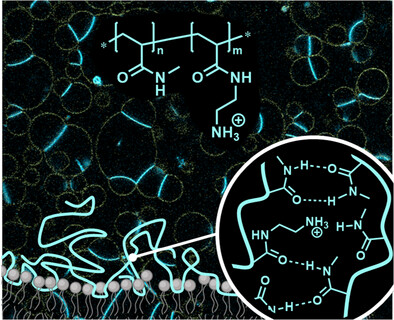
Completely non-amphiphilic antimicrobial polymers (APs) that possess significant bioactivity and excellent selectivity are presented. The importance of hydrogen-bonding interactions is highlighted by segregation of APs on bacterial membrane models and bacteria, a behavior absent in amphiphilic polymers. A supramolecular multivalence is proposed that leads to increased membrane activity without the necessity for hydrophobicity.

Wide-Temperature, High-Voltage, Flame-Retardant Electrolyte for 4.8 V Li||NCM94 Batteries
Chao Li, Yong Li, Tao Su, Lei Liu, Zhimeng Hao, Gaojing Yang, Jianmin Ma
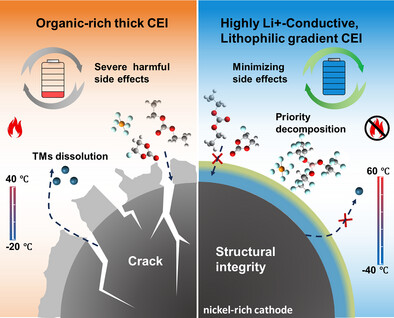
In this work, we construct a highly Li+-conductive, lithophilic gradient CEI based on a high-voltage, wide-temperature and flame-retardant electrolyte for stabilizing Li||NCM94 battery at high voltage (4.8 V) and extreme temperatures (−40∼60 °C).

Selection of Ribofuranose-Isomer Among Pentoses by Phosphorylation with Diamidophosphate
Dr. Harold A. Cruz, Prof. Dr. Ramanarayanan Krishnamurthy
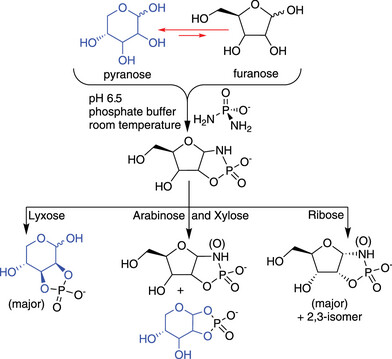
Diamidophosphate phosphorylates the four pentoses under mild aqueous conditions. Ribofuranosyl-cyclicphosphates are formed efficiently, while the other three pentoses react slowly to form furanosyl- and/or pyranosyl-forms. The selective formation of ribofuranosyl-1,2-cyclicphosphate occurs even when starting from a mixture of sugars suggesting an alternative pathway for abiotic synthesis of ribonucleotides in a prebiotic context.

Switching Photocatalytic Methane Oxidation Toward Ethanol by Tuning Spin States
Shuya Hao, Maoyin Wang, Leshen Zhang, Dr. Ximeng Lv, Dr. Chen Peng, Yuhang Huang, Prof. Pei Yuan, Prof. Qing Han, Prof. Gengfeng Zheng
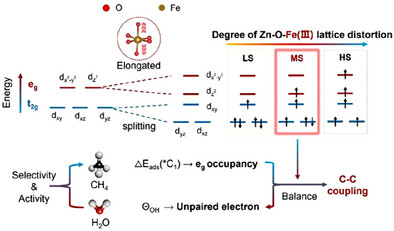
We developed a Zn-O-Fe(MS) photocatalyst with medium-spin active sites, in which both the unpaired electrons and eg orbital occupancy allow to selectively generate •CH2OH intermediates at moderate *OH coverage and promote the C─C coupling of •CH3 and •CH2OH, leading to efficient photocatalytic conversion of CH4 to ethanol without the addition of strong oxidizing reagents.

Orthogonal Multiple Hydrogen Bonds of Nucleobases Enable Precise Tunability of DNA-Polymer Nanostructures
Yuan Xue, Huijuan Chen, Nan Yao, Siyu Guo, Ziyi Gui, Prof. Dr. Zan Hua
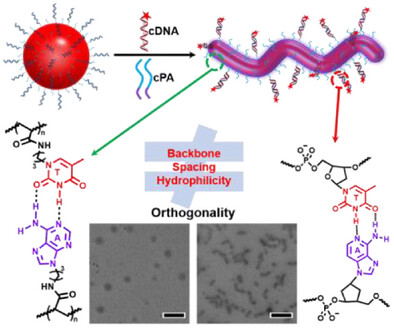
Multiple hydrogen bond (MHB) interactions for hydrophobic nucleobase-containing polymers and hydrophilic DNA chains are highly selective and orthogonal, owing to the heterogeneous backbone structures, distinct repeat unit spacing, and different hydrophilicity. Orthogonal MHBs enable us to tailor DNA nanostructures by exploiting the underexplored hydrophobic domain, amplifying the production of diverse functional DNA nanostructures.

Donor-Acceptor Porous Aromatic Framework Cathode with Fast Redox Kinetics for Ultralow-Temperature (−70 °C) Potassium-Organic Batteries
Jie Yu, Xupeng Zhang, Yuying Liu, Linqi Cheng, Prof. Heng-Guo Wang, Dr. Fengchao Cui, Prof. Guangshan Zhu
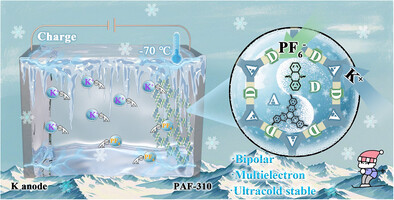
We propose the novel concept of the application of donor-acceptor porous aromatic framework (named as PAF-310) constructed from two types (n-type and p-type) storage blocks to accelerate charge transport and thus facilitate the reaction kinetics in potassium ion batteries, which shows the impressively electrochemical properties at room and low-temperature (even −70 °C) with the anions and cations co-storage mechanism.

Self-Adapting Lattice Respiration Enabled by Crystal Design and d-p Orbital Hybridization Toward Highly Stable Rechargeable Aluminum Batteries
Huaizhi Wang, Dr. Yu Li, Bo Long, Shuqiang Li, Xueying Lu, Shijie Zhou, Prof. Feng Wu, Prof. Ying Bai, Prof. Chuan Wu
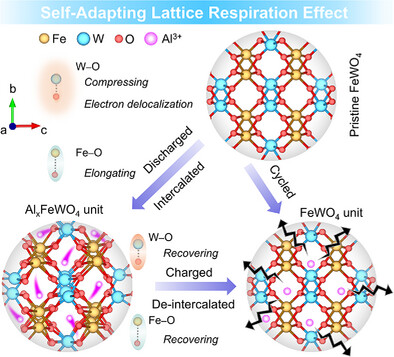
Based on the dual considerations of crystal structure and electronic structure, we construct cathodes with “self-adapting lattice respiration (SALR)” effect. The effect effectively addresses the poor cycle stability of transition metal-based RABs cathodes caused by the strong electrostatic interaction between high charge density Al3+ and host lattice.

Cobalt-Catalyzed Stereodivergent Semihydrogenation of Alkynes: Synthesis of E- and Z-Alkenes
Xiang Ren, Peng Lu, Chenggong Zheng, Prof. Yong Wang, Prof. Zhan Lu

Under the synergistic catalysis of an 8-OIQ cobalt catalyst and CH3CN, a series of E- and Z-alkenes with high stereoselectivity could be synthesized in the semihydrogenation of internal alkynes. Mechanistic studies showed that the acetonitrile plays an important role in controlling isomerization and inhabiting over-hydrogenation during the conversion process.

Nylon-6 Precursor Electrosynthesis From Low-Concentration NO via Carbon-Enhanced NO Adsorption and Improved Mass Transfer
Xinyu Liu, Chuanqi Cheng, Jinghui Zhao, Prof. Bin Zhang, Prof. Yongmeng Wu
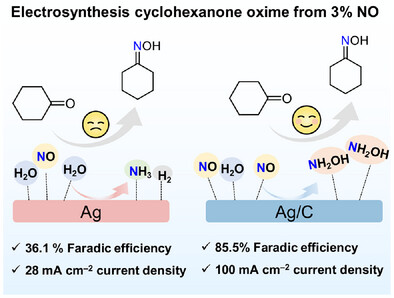
Porous carbon-supported ultrasmall Ag nanoparticles are designed to achieve 85.5% FE at a partial current density of 100 mA cm−2 for cyclohexanone oxime with a 3% NO concentration, outperforming pure Ag nanoparticles. Porous carbon can optimize the NO transport path and H2O molecule distribution on the catalyst surface, accelerating the reaction dynamics for cyclohexanone oxime electrosynthesis and suppressing the formation of ammonia and hydrogen byproducts.

Tuning Eley-Rideal Mechanism in Electrochemical Acetylene Semi-Hydrogenation
Chengyi Zhang, Jiguang Zhang, Zihao Jiao, Yanwei Lum, Ziyun Wang

The ER mechanism plays a vital role in electrocatalytic hydrogenation, yet its rate-limiting factors remain poorly understood. Using acetylene hydrogenation as a model, we uncover atomic activation and spatial hindrance as key ER bottlenecks. Cu3Au, with balanced adsorption strength, exemplifies how introducing weak-binding atoms into moderate-binding hosts can optimize ER activity.

Gold and Bismuth Trimetallic Synergistic Redox Catalysis for Non-Directed C─H Arylation with Aryl Bismuth
Duan-Yang Liu, Sitian Zhou, Linhan Tian, Honglei Zhang, Prof. Wei He, Prof. Kai Guo, Prof. Congqing Zhu, Prof. Chengjian Zhu, Prof. Sergey N. Konchenko, Weipeng Li, Prof. Jin Xie

A dinuclear gold catalyzed selective C─H arylation by using aryl bismuth reagents as the arylation reagents has been developed. The Bi(V) generated in-situ can oxidize gold(I) to form Au─Au─Bi intermediate, where Bi's Z-type coordination mitigates steric/electronic constraints. This trimetallic strategy outperforms classical C─C couplings, tolerating silanes, boronate esters, and germanes, thus providing new insights for multimetallic cooperative catalysis.

Synergistic Enhancement of Photocatalytic Hydrogen Evolution in Covalent Organic Frameworks via Isoreticular Design, Isomerism, and Protonation
Wenbo Dong, Xingjiang Yu, Zhiying Qin, Yushuang Chen, Shijie Ren, Longyu Li
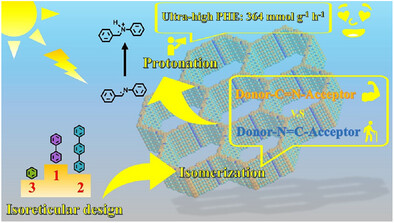
Three isoreticular COFs were synthesized by incrementally extending the organic linker from benzene to biphenyl to triphenyl, alongside their reversed-imine-orientation isomers, enabling a clear comparison of structural effects on activity. Notably, by optimizing protonation conditions, the biphenyl-linked COF-920 achieved an unprecedented hydrogen evolution rate of 364 mmol g⁻¹ h⁻¹ under UV-visible irradiation, as rigorously confirmed by water-drainage and gas-gathering experiments.

Introducing Steric Bulk Into Silylboranes: Enhanced Bench Stability and Novel Chemical Reactivity
Rikuro Takahashi, Prof. Dr. Julong Jiang, Prof. Dr. Satoshi Maeda, Prof. Dr. Hajime Ito

Following initial experimental and theoretical studies that indicated that silylboranes decompose via oxygenation, bulky silyl anions were used to synthesize silylboranes with enhanced bench stability and novel reactivity. These kinetically stabilized silylboranes are stable in air and moderately activate carbon monoxide (CO) to form spirocyclic compounds. DFT calculations suggested that the activation of CO is driven by hyperconjugation.

Anion-Dominated Calendar Aging in Aqueous Zinc Metal Batteries
Jiaqi Wang, Prof. Bao Zhang, Sha Luo, Xiao Huang, An Duan, Haotian Chen, Prof. Wei Sun

Anion-dominated plating morphology governs the calendar aging of aqueous zinc metal batteries. Notably, corrosion severity does not directly correlate with aging-induced degradation. Electrolytes that promote smoother zinc deposition, quantified by a lower plating roughness factor (Prf), exhibit enhanced resistance to calendar aging. Leveraging this insight, an acetatization strategy achieves up to a 49-fold reduction in calendar aging-induced degradation.

Ligand-Mediated Activity of Cu4 Clusters Boosts Electrocatalytic Nitrate Reduction
Hong Chen, Kong-Sheng Qi, Xiao-Yu Dong, Ya-Ning Pei, Yu-Jie Jin, Han Zhang, Si Li, Jie Wu, Jinmeng Cai, Shuang-Quan Zang
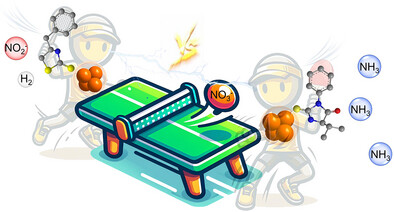
Using a tetranuclear copper cluster as a model, we modulated coordination microenvironments to boost electrocatalytic nitrate reduction performance, uncovering atomic-level structure-activity correlations and offering precise ligand-engineering strategies for advanced catalyst design.

Ferromagnetic Ordering Outperforms Coordination Effects in Governing Oxygen Reduction Catalysis on High-Index Nickel Single Crystals
Menglong Sun, Jiabin Chen, Zhibin Zhang, Yuan Jing, Mengze Zhao, Lili Chen, Prof. Kaihui Liu, Prof. Chuang Zhang, Prof. Xi Wang, Prof. Jiannian Yao
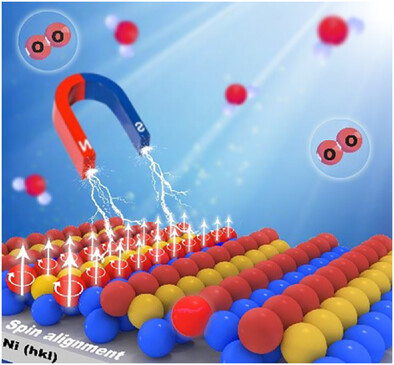
Our study explored the link between ferromagnetic ordering, coordination number, and ORR activity in nickel single-crystal foils. We found that Ni (210) facets outperform Ni (310) and Ni (520) due to higher saturation magnetization and optimized d-band positioning. DFT calculations confirmed that ferromagnetic ordering, not surface coordination, drives catalytic performance by enhancing spin polarization and lowering energy barriers. External magnetic fields further boosted the activity of Ni foils.

Zwitterionic Heavier Pnictinidenes in Redox Catalysis
Selwin Fernando, Dr. Yi Chen Chan, Dr. Sergio Fernandez, Enric Sabater, Dr. Graham Tizzard, Prof. Simon J. Coles, Dr. Diego M. Andrada, Dr. Oriol Planas

Zwitterionic pnictinidenes: A new class of zwitterionic heavier pnictogen species stabilized by bis(N-heterocyclic carbene)borate ligands is reported, enabling the isolation of Sb and Bi in multiple oxidation states. These thoroughly characterized systems exhibit cationic character and engage in redox catalysis, facilitating catalytic hydrodefluorination and dehydrogenative thiolation of silanes, expanding the scope of main group redox chemistry.

Unexpected Activities of CYP152 Peroxygenases Toward Non-carboxylic Substrates Reveal Novel Substrate Recognition Mechanism and Catalytic Versatility
Dr. Yuanyuan Jiang, Piqian Gong, Zijia Li, Dr. Zhong Li, Yuxuan Li, Prof. Dr. Binju Wang, Dr. He Huang, Prof. Dr. Wei Peng, Prof. Dr. Xiang Gao, Prof. Dr. Shengying Li

The study unveils novel aromatic hydroxylation and dehalogenation activities of CYP152 peroxygenases toward various aromatic pollutants without any carboxyl group. Mechanistic analyses provide new insights into non-carboxylic substrate-assisted acid-base catalysis for hydrogen peroxide activation, inspiring potential applications in industrial biocatalysis and environmental remediation.

Polyolefin-based Multiblock Copolymers from Cascade ROMP-RAFT Polymerization
Prof. Min Chen, Dr. Guifu Si, Prof. Wen-Jian Zhang, Prof. Changle Chen
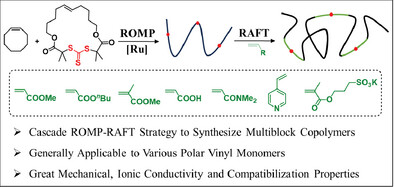
A ROMP-RAFT cascade polymerization strategy was designed to synthesize polyolefin-based multiblock copolymers, which were employed as compatibilizers to upcycle mixed plastics.

Chemically Recyclable Alternating Poly(thioether-alt-ester)s with Tunable Properties Enabled by Substitution Effects and Stereochemistry
Mingqian Wang, Zhiqiang Ding, Jingying Xiao, Yilong Liao, Prof. Dr. Zhe Ma, Prof. Dr. Yuesheng Li, Prof. Dr. Bin Wang
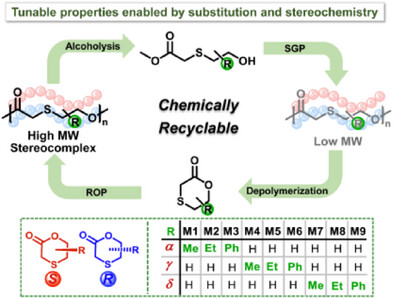
Poly(thioether-alt-ester)s with structurally diversity were synthesized by a “polycondensation-depolymerization-repolymerization” strategy. The strategic positioning of α-, γ-, and δ-substituents coupled with stereoregular chain architectures and stereocomplex formation enables wide-range modulation of the polymer's thermal and mechanical properties.

Oxidative Electrocyclization Assembles 2,2-Dimethyl-2H-pyran in Fungal Indole Alkaloids
Chengjie Zhang, Jingxuan Zhou, Wei Wang, Mingyu Liu, Yuanning Li, Xiang Sheng, Lei Du, Shengying Li
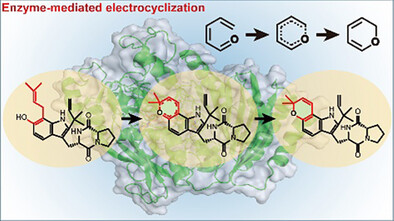
A berberine bridge-like oxidoreductase mediates oxidative electrocyclization to form the 2,2-dimethyl-2H-pyran (DMP) ring in fungal indole alkaloids. Heterologous gene expression, in vitro enzyme activity reconstitution, and mechanistic studies unveil nature's strategy for pyran formation via enzymatic electrocyclization, expanding biocatalytic pericyclic chemistry.

Electrocatalytic C─S Cross-Coupling via Engineered Frustrated Lewis Acid-Base Pairs for High-Efficiency Methanesulfonate Synthesis
Yuhang Gao, Menglong Sun, Yuan Jing, Kaiheng Zhao, Lili Chen, Prof. Yangyang Guo, Prof. Zhiqin Liang, Prof. Yijun Yang, Fangli Yuan, Prof. Tingyu Zhu, Prof. Xi Wang, Prof. Jiannian Yao
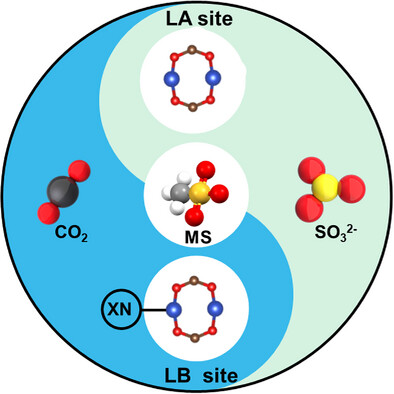
This study demonstrates that MOFs catalysts with Lewis acid-base sites generated by introducing specific ligand groups can produce methanesulfonate through nucleophilic attack, and performance is superior to previously reported copper-based catalysts. This work highlights the importance of the Lewis acid and base sites for electrocatalytic C─S coupling reaction and provides an avenue to produce by abundant resources and renewable electricity.

An Atomically Precise Copper Cluster Nanoreactor for Efficient Catalysis in Chemical Fixation of Low-Concentration CO2
Wan-Zhen Qiao, Bing-Jie Xue, Rui Wang, Yuan Yang, Prof. Shuang-Quan Zang
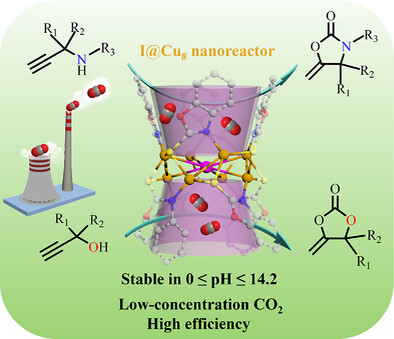
An atomically precise I@Cu8 cluster with high thermal/chemical stability represents the first example of a cluster-based nanoreactor that demonstrates excellent catalytic activity in chemical fixation of both propargylic amines and propargylic alcohols with CO2 at simulated flue gas concentrations due to the unique substrate enrichment of well-defined nanocavities.

Chiral Self-Sorting of Flexible Covalent Organic Pillars for Adaptive Molecular Recognition
Dr. Shengnan Gao, Min Zhang, Yimin Zhang, Dr. Congsen Wang, Prof. Andrew C.-H. Sue
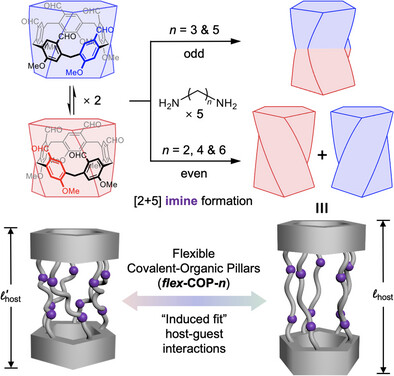
Flexible covalent organic pillars (flex-COP-n) are adaptive nanotubular hosts formed via dynamic imine condensation. Their self-assembly displays an odd-even effect, yielding enantiomeric or meso duplexes. Host-guest studies reveal binding modes shaped by mutual deformation and geometric complementarity, underscoring their capacity for responsive molecular recognition.

Trigonal Planar Bis(carbene)Cu(I) Complexes Enable Divergent H2 Activation with H2O for Accelerated Olefin Hydrogenation
Dr. Evan A. Patrick, Prof. Dr. Shaama Mallikarjun Sharada, Anya Zoraster, Dr. Jeremy D. Erickson, Dr. David E. Ryan, Dr. R. Morris Bullock, Dr. Ba L. Tran

Trigonal planar naphthyridine-bis(carbene)Cu(I) alkyl, hydroxide, and ethoxide complexes promote a divergent mechanism of H2 activation for the rare catalytic hydrogenation of unactivated alkenes at mild conditions at copper.






